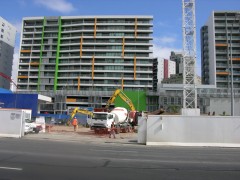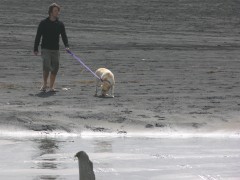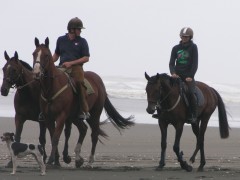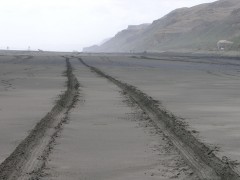Major Report: State Of Car-Crazy Polluted Auckland & It’s Not Pretty
A major ARC briefing, for the upcoming new super-city, on the state of Auckland, warns of serious deteriorating environmental matters in an increasingly car-crazy city, that will get even more car addicted and polluted.
It says that public transport has seen huge growth in patronage as a result of greatly improved services and promotion but warns that reducing funding of public transport (which is what has happened recently with the new government funding ratio scheme) “is likely to arrest these gains and potentially see people return to their cars.”
But to be honest- it’s not a case of Aucklanders returning to their cars. Aucklanders can’t get enough of them.
Despite the gains in public transport (have these been reduced lately with all our train problems?), the level of car ownership has increased across the Auckland region, with 17% of households now having three or more vehicles compared to 14 per cent just five years earlier.
In addition, vehicle engine sizes and fuel consumption are both trending upwards.
And Aucklanders are driving more in their vehicles. In 2007, the average Auckland resident drove an extra 275km a year compared to 2000.
This increased driving distance was additional to a higher general use of public transport.
The report says many impacts and pressures on Auckland are related directly to transportation, land use, housing development. They arise from the need to develop, maintain and extend the transport infrastructure (roads, rail, sea ports and airports) and include the associated exposure to new pest species arriving as a result of overseas trade and tourism.
But the increasing use of motor vehicles and more of them is affecting Auckland’s air quality - and it needs reduction but there’s no help in sight..
The report states: “With respect to air quality, emissions of PM 10 and PM2.5 particulates and NO 2 all need to be reduced substantially to meet national standards and protect human health. Motor vehicles and domestic heating are the major contributors of these pollutants.”
The report can’t see our air getting any cleaner, because of Auckland’s addiction to motor vehicles.
“Overall emissions from vehicles will continue to be about the same despite improvements in vehicle technology simply because there are likely to be more kilometres travelled (notwithstanding public transport investment).
“Emissions from domestic home heating may decrease slowly but only to the extent that we meet internationally accepted air quality standards in about 25 years time.
“Although air quality is likely to remain the same, a larger and denser population will see more people exposed to air pollution with associated increases in mortality and reduced activity days (days when people feel too unwell to do their normal activities).”
And air quality isn’t our only serious deteriorating issue.
The ARC’s briefing, an extensive picture of Auckland’s air, land, water and biodiversity, warns that as our population and economy grows and intensifies, even greater pressure will be placed on our environment.
“It’s a big challenge and one the new Auckland Council will have to tackle head on.”
And as the ARC, despite decades of monitoring, says it doesn’t have all the solutions for the rising problems, this makes those chosen for the future governance of the city, and the attitude of central government critical.
The way the lengthy report puts it: “The challenges of the next 20 years may well require tools that we do not currently have and powers that we may never have. This will mean that we need to maintain a close working relationship with others, including central government. Our future success in securing good environmental outcomes for the region will always depend in part on convincing central government of the importance of our work.”
It predicts the regional population could reach two million by 2035 – an increase of around 500,000 people or 40 per cent more than our current population of 1.37 million.
Between 2001 and 2006, about 16,700 more people moved from Auckland to other parts of New Zealand (mainly Northland, Waikato and Bay of Plenty) than moved into the region, a loss considered relatively small and anyway offset by a surge in international migration.
The report rightly emphasises the good work the ARC has done over the years, such as with pest control. But thanks to the changing face of Auckland and pressures that population growth brings, a very worrying picture of Auckland, just around the corner, emerges.
Key problems are all around us:
- Soil quality is likely to degrade further with increased compaction, excess nutrients and changes in soil carbon levels which effect soil structure and nutrient retention.
- While we have new technologies to reduce inputs from stormwater, the suite of contaminants we are dealing with is an increasingly complex mix and the cost of intervention can be prohibitive
- Our marine area is likely to continue to decline at a gradual rate, with many changes too subtle to observe until it is too late.
- Key changes are likely to be a decline in species diversity and loss of large species.
- Currently the most degraded marine areas are close to the centre of Auckland reflecting land use impacts. However this footprint of impact may spread further along Auckland’s coastline as rural land practices generate discharges of nutrients and sediments and urban Auckland expands.
- As the region’s population expands there will be increased access to, and use of, the marine environment creating additional pressures on marine resources such as space, food resources and minerals. At the regional scale, native habitats and threatened species will continue to decline in unprotected or unmanaged areas due to habitat loss, fragmentation and invasive species.
- As population growth and urban expansion increases, new areas will be exposed to natural hazards while the potential consequences of an event may become greater, even if the magnitude of environmental processes have not increased.
- Auckland’s continued role as the country’s dominant manufacturing base, particularly for high value goods, also has a range of environmental impacts associated with the production and disposal of liquid, gaseous and solid wastes (including hazardous waste) although these pressures are small by international standards.
- We need to become more resource efficient. That will require both technical advances and behavioural change.
- While rates of water consumption have fallen to internationally modest levels, there are challenges ahead in managing solid waste, energy demand and transport.
- Loss of land to urbanisation continues. Notwithstanding the Auckland Regional Growth Strategy, we continue to lose prime agricultural land to urbanisation. Outside the MUL residential development is intensifying – sometimes in environmentally sensitive locations.
- Rural activities are exposing land to increased risk of erosion, soil degradation and sediment loss to aquatic environments. Water quality and ecological health in the region’s rivers are highly influenced by land cover in the catchment. Most of the rivers and lakes in the region are degraded to some extent. Urbanised catchments generally have poorest water quality although there are signs that this is improving. Lake water quality is degraded due principally to nutrient enrichment and invasion by exotic species.
- Plumes of sediment are often visible in the marine environment following large storms, with water clarity often taking several days to improve. Increased sedimentation is a real and significant impact impinging on aquatic environments. Large sediment runoff events can lead to sediment dumps, which smother marine life. Ongoing, incessant sedimentation leads to the slow, irreversible degradation of the marine environment, particularly in sheltered harbours and estuaries. Clear signs of this include increases in the “muddiness” of estuaries and mangrove expansion.
- Several ecosystem types are severely depleted in the region and are under threat from further loss and fragmentation of habitats (as a result of urban or rural land development) and the impacts of invasive species.
- Like most parts of the country, the Auckland region is exposed to a range of geological, climatic and coastal hazards. The majority of recent events have related to climatic hazards (flooding, landslides and cliff instability).
- Aucklanders are generally not well prepared for natural hazards and lag well behind other regions.
Of course, many of these environmental disasters are happening without us being aware of them, as we rush around the city, in one of our three SUVs!.
For example, heavy metal contaminants in estuarine muddy habitats are impacting upon marine species leading to a decline in ecosystems adjacent to urbanised catchments. Concentrations of zinc in the sediments of estuaries and harbours are increasing and new organic contaminants are emerging as potential concerns. The stormwater system is the primary transporter of these contaminants.
The ARC’s modelling shows that stormwater is contributing large volumes of sediment, zinc, copper and bacteria to aquatic systems. Zinc levels tend to be high from catchments with historically high industrial landuse. The extent of impervious surface within the metropolitan area has increased giving rise to greater stormwater volumes and contaminant loads.
In addition there are a large number overflows from the Auckland combined stormwater/wastewater system during wet weather, which will continue until these systems are fully separated.
On the issue of our water, it’s disturbing to note that although gains have been made in urban water quality in recent years, “it’s likely that we have exhausted the potential improvements using the current approach to managing discharges. Freshwater quality in rural areas is similarly likely to stay the same although some marginal improvement may be expected if non regulatory approaches are effective.”
Looking ahead, the report warns that we face the task of addressing the more challenging diffuse sources of pollution. These are discharges that do not emanate from a single pipe or stack, or even a single user but rather from multiple, small, difficult-to-target sources. Particular examples of concern include run-off from land into surface or ground water following rainfall or the cumulative contribution of many home fires burning during winter.
“This new focus will necessitate greater landowner and stakeholder engagement to manage land use practices more effectively.”
The briefing makes no pretense there is any silver lining.
“We will inevitably face conflicts between competing objectives. We know already that we need to manage intensification of metropolitan Auckland carefully if we are to avoid exposing more people to greater air pollution. We also know that in seeking to retain rural Auckland in primary productive use ,we need to be conscious of the impacts of such use particularly as the sector moves to more intensive production.”
All this makes it important, we all think hard before electing people to the new super-council this October.
These problems will be handed to them, and this bulky report lands in their in-tray, the moment they take office on November 1.
By the way, the report -despite the ARC’s recent complaints about the CCO structure in the new local government reform, concludes:
“On a positive note, the Auckland governance reform offers a real opportunity to more effectively address many of the issues that have proved difficult historically. Urban growth management and stormwater and wastewater system performance, in particular, are issues that require close integration between regional and territorial tiers of government. Moving to a single governance structure for the region offers an opportunity to move ahead on these and other issues with much greater confidence and efficiency. The settling of Treaty of Waitangi grievances and the aspirations of tangata whenua for co-management present yet more opportunities to exercise stewardship and kaitiakitanga in the best interests of all Aucklanders.”















11 Comments
Got a link Jon? The whole report sounds like it’s worth a read.
Over 300 pages its good bedtime reading. I presume they’ll put at least a summary up.
Thats just an H2, the beauty is the original Hummer!
As the rest of the world is putting on more public transport it seems Auckland builds more car parks. So dumb. Auckland needs to look in the mirror. My girlfriend and I were in Dublin over the last 4 days, and before we left I was told the public transport was not as good as other cities. We spent our time exploring the sites by rail, tram and bus, everything was on time and frequent. I would have preferred the bus stops to have more thorough bus maps showing the links to other bus routes. No rail went to the aiport but it’s on it’s way http://www.railway-technology.com/projects/dublin-metro/ . So Dublin doesn’t have rail to the airport yet, (but a bus that leaves every 10 minutes) and the bus stops could have better information and that’s about it. And people say it doesn’t have a good public tranport system? What do tourists say about Auckland?
@joshua I’ve seen an original driving through Onehunga, from the same real estate company too! It looked like the US army had arrived or something.
[...] in Auckland …"But the increasing use of motor vehicles and more of them is affecting Auckland's [...]
Looks like Hummer is dead as no buyer can be found.
http://www.nytimes.com/2010/02/26/opinion/26fri4.html
All Hummers should be preserved un-operational as a monuments to extreme over-indulgence and short-sightedness.
This is worrying, I didn’t realise it was this bad…
I disagree with the statement Aucklanders can’t get enough of their cars… We are travelling more in all modes, which is good economically but we have no other options…
I didn’t know all this was happening. It’s definitely troubling seeing all these cars being produced, and in consequence to that we see a lot of pollution. Thanks for posting this article though.
I see a lot of information about Aucklanders and cars and can’t help but wonder what the ratio’s are in the rest of the country. Is the problem that Aucklanders love their cars or simply that the public transport available is so limited as to be unviable for the majority - unless you happen to work a 9-5 job in the city. We live in Waitakere City in an area with no access to trains (unless of course we can drive, find a park and then use the train). We have a friends daughter staying from overseas - and tried to get her into town on Saturday. The ferry - which would have been perfect - doesn’t run weekends. Hourly buses were available however, these go from West Harbout -through to Henderson/ New Lynn and all over the show - before getting into town. This meant she sat on the bus for over 4 hours on Saturday - just to meet a friend in town. Gosh - I wonder why Aucklanders hold onto their damn cars.
Letticia - agreed, weekend services are often a disgrace, as simple as that.
It’s the old idea that public transport should be (if at all) be good enough to take the edge of the peak hour traffic, but isn’t worth bothering about at other times.